Recently off the reading stack!
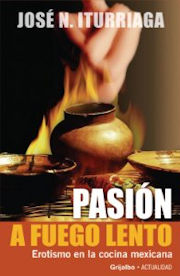 Pasión a fuego lento. Erotismo en la cocina mexicana by José N. Iturriaga
Pasión a fuego lento. Erotismo en la cocina mexicana by José N. Iturriaga
A fascinating look at sex, mores, and eroticism in Mexican culture against the backdrop of the evolution of the country’s cuisine. The author approaches the subject from a combination of historical, anthropological, archaeological, and philosophical viewpoints. He weaves together an interesting tapestry of dishes and ingredients and what they represent in sexual and spiritual terms, both to the indigenous Mexican culture, and to the colonizing Spanish. He does tend to favor, or at least cite, the Spanish viewpoint far more than the native one, but that may well be a simple matter of the written record that is extant in this day and age. As was recently pointed out to me, much of the indigenous culture lived in what anthropologically anyway, is considered “prehistory” because it predates written records. The book was a bit of a slow read for me, a combination of a lot of terms and colloquialisms that I simply wasn’t familiar with and had to look up (the book is in Spanish, I should point out, if it wasn’t obvious), and a huge number of foot and end notes. Still, for anyone for whom the topic is a “pasión”, it’s worth delving into. **** 5/5
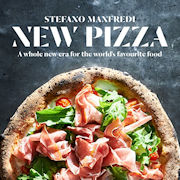 New Pizza: A whole new era for the world’s favourite food by Stefano Manfredi
New Pizza: A whole new era for the world’s favourite food by Stefano Manfredi
Stefano Manfredi and I met, back in the early 90s, when I went to Sydney for the first time, visiting my then quasi-boyfriend who was living there for a year or so for work. He took me out to dinner at Stefano’s The Restaurant overlooking Darling Harbour. There, I had an absolutely spectacular meal, and, for whatever reason, as it’s not “usual”, Stefano and I exchanged contact info, and we’ve stayed in touch by internet, in one forum or another, over the years. The Restaurant is no longer, and these days his focus is on teaching and recipe development, and writing. His latest, and second, book is an in-depth look at what the Italian staple, pizza, has become as it has conquered the world. While his focus is on “new pizzas” as they’ve come to be in Australia, he covers a wide range of different ethnic cuisine fusions with, or supplanting, the classic “tomato pie”. The writing is engaging, the recipes are mouthwatering, and the photos are simply stunning. Best pizza book I’ve read in a very long time. ***** 5/5
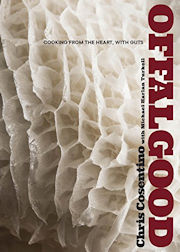 Offal Good: Cooking from the Heart, with Guts by Chris Cosentino
Offal Good: Cooking from the Heart, with Guts by Chris Cosentino
These days, it’s not often that I read a “chef-y” food book and do much more than make a note of a recipe or two that sound interesting to make, one day, some day, or that give me inspiration to try something new. Most of the book then gets relegated back to the electrons it came in. This is one of the first in a long while that I’ve added a “to be bought in hardcover form” on my next trip somewhere where that’s a possibility. I want to try most of the recipes in the book, and I love the way it’s written, and illustrated. The in-depth coverage of every part of the animal, and not just the usual suspects of cow and pig, makes this an offal lovers dream. Excellent! ***** 5/5
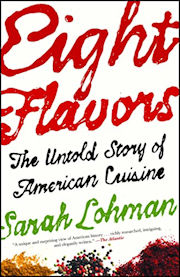 Eight Flavors: The Untold Story of American Cuisine by Sarah Lohman
Eight Flavors: The Untold Story of American Cuisine by Sarah Lohman
Lohman approaches what she considers the defining flavors of modern American cooking in an easy to read, interesting manner. She covers the history of each flavor’s introduction to American cuisine, how it gradually inserted itself into more and more of what we make, and how it’s used in today’s cookery. I’m not 100% on board with her choice of black pepper, vanilla, curry powder, chili powder, soy sauce, garlic, MSG, and Sriracha as the defining flavors of the modern American palate – in many ways it feels a bit like a “coastal elite” perspective. Yet, at the same time, even in the heartlands of the U.S., these flavors have certainly had an impact, and can be found, and would be recognized by most home cooks, and certainly in restaurants. Lohman can get a little long-winded, particularly in the historical parts of each section, and there were moments when I just wanted her to get to the point, but in the end, a great read, and well worth it for someone interested in American cooking and its history. **** 4/5
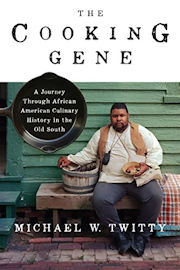 The Cooking Gene: A Journey Through African American Culinary History in the Old South by Michael Twitty
The Cooking Gene: A Journey Through African American Culinary History in the Old South by Michael Twitty
Michael Twitty first came to my attention when he penned his now famous, viral letter to Paula Deen after she used “the N word” in a public broadcast. He should have come to my attention far sooner, as the brilliant author of the equally brilliant Afroculinaria blog. Hailed as one of the best food writers in America these days, it’s an accolade well deserved. His work is insightful, well-researched, and completely engaging. So when I heard that he was publishing a book exploring the roots of Southern cuisine in African American tradition, I put it on my to buy list. And, at some point I did, and then a bit later on actually tucked into it. It’s as good as I’d hoped. I doubt there’s anything else out there, even scholarly works, that delves as deeply, or as personally, into this topic, and for anyone who cares about Southern cuisine, African American cuisine, racism, and/or politics, it’s a must read. ***** 5/5
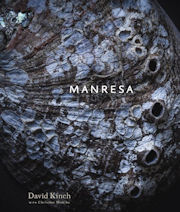 Manresa: An Edible Reflection by David Kinch
Manresa: An Edible Reflection by David Kinch
Okay, we can all yawn. It’s another book by a famous chef who’s doing precious, pretty food, and thinks we need yet one more coffee table book that we’ll never look at after a skim through the day it arrives. Maybe, in some ways, that’s the plus of having picked this one up on Kindle, is that it had no place to sit other than on my reading “stack”. And I was interested after seeing his portion in season 4 of the Mind of a Chef series. So, I read it. Cover to cover. Which is something I don’t often do with this type of book. But Kinch takes a really intriguing approach to the topic, diving deep into the reasons behind the food that he prepares and presents. He’s got a great philosophy about life and food and how they interact, and he really brings it into focus in the pages of this book. And, hey, like others of the genre, it’s stunningly photographed. **** 4/5
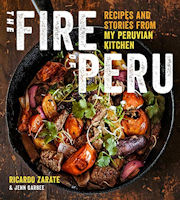 The Fire of Peru: Recipes and Stories from My Peruvian Kitchen by Ricardo Zarate
The Fire of Peru: Recipes and Stories from My Peruvian Kitchen by Ricardo Zarate
My friend Kevin asked me about this book, and while I was distantly familiar with Zarate, I’ve never been to his restaurant, and didn’t know about the book. But I’ve heard great things about the restaurant, and I thought, what the heck, let me take a look at the book. Now, to some extent, it’s just another Peruvian cookbook to add to the dozen or more that I already have on my shelf. There aren’t any truly stunning recipes, or things that I suddenly discovered about Peruvian food that I’d never known before. And to be honest, it’s not as well researched, particularly in the history of the influences of various cultures, both indigenous and the heavy Chinese and Japanese bent in modern Peruvian cooking as I might like. He gets some details just plain wrong. But what made it of particular interest was the varied personal anecdotes about growing up in, and visiting Lima, and the food scene there. Perhaps it was a simple matter of timing, with reading this just prior to my recent trip there, but it added to my list of things to see, try, and places to go, that I otherwise likely would have missed. For that alone, it was worth the read. And if you don’t have a cornucopia of Peruvian cookbooks on your shelf, it’s certainly a worthwhile one to add to your collection. **** 4/5
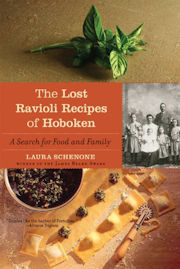 The Lost Ravioli Recipes of Hoboken: A Search for Food and Family by Laura Schenone
The Lost Ravioli Recipes of Hoboken: A Search for Food and Family by Laura Schenone
Damn. Umm. Yawn. I really wanted to like this book a lot more than I did. I used to live in Hoboken, I love pasta, I love personal searches for family and food history. And there’s no doubt that Schenone really gets into that search – multiple trips to Italy, to the region her family came from, seeking out long lost relatives, talking with food historians and chefs, trying a plethora of different recipes and techniques, all the while looking for that lost family recipe. And she does that really well. But she also does it interminably. The book goes on, and on, and on. There’s too much detail, and too much of it is of the, let me jot down every little thing I did and thought that whole day, variety. She even, towards the end, acknowledges that a good storyteller would have not only stopped long before, but given a cool wrap-up that brought it all together. And then acknowledges she’s not going to do that, and plunges right back down the rabbit hole. This book needed to be about 1/4 to 1/3 shorter, with a lot of judicious editing and making the writing flow. It’s still an interesting read, but you’ll need to take breaks, over and over and over again. *** 3/5 [Sept. 3, 2018: Going on 6 months after this review, the author emailed to tell me that I’m mean and sneering and she’s never seen anything like this, nor felt compelled to write to a reviewer before. Apparently my finding her book long and overly detailed is worse than the actually negative reviews she’s gotten, calling her pretentious, elitist, self-absorbed, angry, and boastful. Some found the book to be trash, not worth reading, repetitive, disappointing, the prose and story wore thin, drawn out, a struggle to finish, or that the book itself was as lost as the recipes it seeks to uncover.]
That wraps it up for this time around. And hey, I just noticed, all these books have subtitles. Is that a thing now?
[…] been almost six months since my last set of book reviews, and scattered between all the mystery, sci-fi, fantasy, and history books I’ve read in that […]